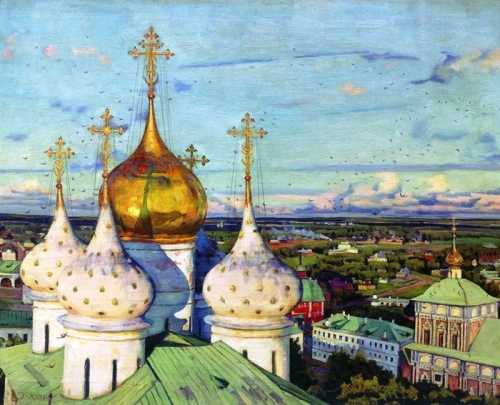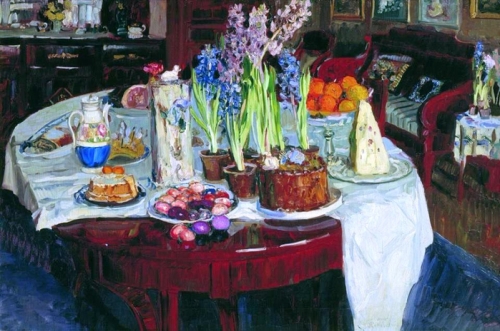29/04/2018
April 27 were born ...
Ivan Petrovich Karpov
commander of the calculation of the machine gun of the 60th Guards Rifle Regiment (20th Guards Rifle Division, 37th Army, 3rd Ukrainian Front), guard sergeant. He was born in the village of Elkhovka, now Totsky district of the Orenburg region (according to other sources - in the city of Tashkent) in the family of a peasant. Russian. He graduated from 6 classes. He worked on the collective farm "New Life", a fitter in the factory. In the Red Army since April 1941. In the battles of the Great Patriotic War since 1942. He fought in the Western, Stalingrad, 3rd Ukrainian fronts, participated in the Battle of Stalingrad, the liberation of Ukraine. By the spring of 1944, Guard Sergeant Karpov was the commander of the calculation of the machine gun of the 60th Guards Rifle Regiment. He distinguished himself in battles when crossing the Dniester River and liberating Moldavia. In April 1944, Guard Sergeant Karpov, alone with his machine gun on a raft, was among the first to cross the Dniester River near the settlement of Slobodzeya (now the city, the administrative center of the Slobodzey region of the unrecognized Pridnestrovskaia Moldavskaia Respublika) and took up defense. With the fire of his machine gun, he silenced the three nearest firing points of the fascists, which prevented the crossing of the advanced units. When the infantry of the enemy went on the attack, Karpov, changing his position, hit the flank with fatal fire. Often changing the firing positions, the machine gunner allowed the units of the regiment with small losses to force the river. Only on the first day of fighting for the bridgehead Karpov suppressed the fire of five heavy machine guns, exterminated more than 30 fascists. On April 13, in a battle near the village of Kopanka (now a village in the Causaan region of Moldova), reflecting the sixth counterattack of infantry and enemy tanks a day, the machine gunner Karpov let the infantry 50 meters away, firing at point-blank range, destroying 36 German soldiers led by an officer. In the submission to the awarding of the heroic title, it is stated: "With his steadfastness, courage and courage, he ensured the successful crossing of the water boundary and the firm consolidation of our bridgeheads on the right bank of the Dniester River." Killed in one of the following fights. About the fate of the warrior after the battles on the Dniester, as stated in the biographical directory, "no exact documentary evidence was found". The decree of the Presidium of the Supreme Soviet of the USSR of September 13, 1944 for the exemplary performance of combat missions of the command on the front of the struggle against the German fascist invaders and the courage and heroism of the Guard, sergeant Karpov Ivan Petrovich, manifested at the same time, was awarded the title of Hero of the Soviet. He was awarded the Order of Lenin.
1913
Elmar Yanovich Keats
Estonian painter, People's Artist of the USSR (1971). Was born in Tartu. He studied at Tartu in the Higher Art School "Pallas" (1935-1939) in A. Wabbe. He taught at the Art Institute in Tartu (1944-1949). The author of thematic paintings, landscapes, still lifes, portraits executed in a free, picturesque manner and distinguished by the subtlety of the coloristic decisions: "High water in Valhamets" (1960), triptych "Music, Ballet, Fine Arts" (1961-1962, Estonian Art Museum, Tallinn) , "VI Lenin", "Builders" (both works of 1969, the State Prize of the Estonian SSR, 1970). He also worked in the field of monumental and decorative painting. He was awarded the Order of the Badge of Honor. He died in Tartu on March 24, 1972. Literature: Erm., Elmar Kits, Tallinn, 1959 (summary in Russian): his same, Uus etapp Elmar Kitse loomingus, "Kunst", 1967.
Heorhiy Narbut
1913
Galina Dmitrievna Kremshevskaya
ballet dancer, ballet critic.
03:13 | Lien permanent | Commentaires (0)
11/04/2018
POETRY OF THE SILVER AGE. Konstantin Balmont

Konstantin Yuon. Domes and swallows. Assumption Cathedral of the Trinity-St. Sergius Lavra, 1921
Annunciation in Moscow
Annunciation and light,
The pussy willow.
Or as if there was no grief,
Right, really?
Evangelism and laughter,
Kidneys flushed.
And on the streets of all
Blue flowers.

How many blue flowers,
Taken from the snow.
Again the world is fresh and new,
And everywhere is negative.
Edouard Vuillard paintings for sale
I see old Moscow
In the young dress.
I laugh and I live,
The sun is in every eye.
From the ancient Kremlin
The ringing floats by the wave.
And in the moats there is a land
Young grass.
In a little grass
A dream of spring and summer.
Annunciation in Moscow,
This is a holiday of light!
Konstantin Balmont
05:41 | Lien permanent | Commentaires (0)
10/04/2018
Poetry and painting: Igor Severyanin and Stanislav Zhukovsky
Poetry and painting:


Fabian Perez Paintings for sale
Igor Severyanin and Stanislav Zhukovsky
Stanislav Yulianovich Zhukovsky (1873 - 1944).
"Easter still life", 1915
Easter in St. Petersburg
The hyacinths smelled in the dining room,
Ham, cake and Madera,
It smelled of the supper of the Passover of Christ,
Orthodox Russian faith.
It smelled like the sun, the window paint
And lemon from the female body,
An inspirationally cheerful Easter,
What was ringing around the bell.
And at the monument to Nicholas
Before the Great Sea,
Where was the pavement of the ends,
I smelled of plaice.
Because of the glasses washed to the Feast,
Because of frames without sand and without cotton wool
The city stomped, rang and clinked,
Kissed, enthusiastically embraced.
It was sweet for the belly and the spirit.
Young people raced, flowers prikolovshi.
And the elders, although it was dry,
Fur coats, cotton wool in the ears and galoshes ...
The poetics of religion, where are you?
Where is poetry religiosity?
All the "idle" songs are sung,
"Business" is now serious ...
Let it be ridiculous, ridiculous, silly
It was in my young years,
But my heart was hugging
That is peculiar only to Russia!
Igor Severyanin, 1926
01:46 | Lien permanent | Commentaires (0)